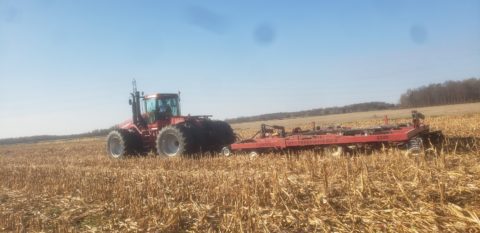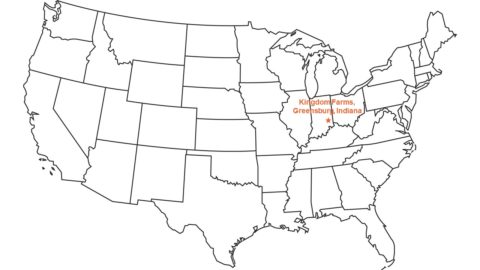Harvest 2022 has gone well on our farm in the U.S. Midwest. The weather has been beautiful for harvest. The crop yields have been average, despite challenging growing conditions throughout the year. And, the work has gone smoothly, with minimal breakdowns.
We started harvesting our high oleic soybeans the second week of October. We delivered these soybeans straight from our fields to an area grain elevator, where our soybeans will be stored with other high oleic soybeans until the crushing plant near Indianapolis is ready to process them.
Then we started shelling corn. First, we harvested corn on the farm where we live. They contained identity-preserved hard endoplasm, or hard endo, corn we raise for dry millers in Japan. We store this corn on our farm until the buyers call for it. Then we truck it to a river terminal on the Ohio River about 90 km, or 55 miles, away. There, it is loaded on a barge that eventually reaches the Gulf of Mexico and is transferred to a ship for delivery.
After that, we switched to harvesting our soy food beans. The soybean plants were mature and dry, so they flowed through the combine easily. This made the process go quickly. Like the food-grade corn, we store these soy food beans on our farm until the buyers are ready for them. Then we take them to the exporter we work with. They clean and bag the soybeans and ship them in containers to tofu producers in Taiwan.
Finally, we returned to shelling our remaining corn, which included more hard endo corn destined for Japan and non-GMO corn we sell to a bourbon maker in the state of Kentucky, just south of Indiana. We finished with harvest by mid-November.
Because we grow specialty crops, we do have to take more than half a day a few times to clean out our combine really, really well. We do this before harvesting our identity-preserved crops —the soy food beans and hard endo corn. We plan the order we harvest crops and fields based on when the combine has to be cleaned, because it takes a lot of time and work.
To clean the combine, we open it up and take out some of the easily removable pieces. Using air hoses attached to an air compressor and leaf blowers, we clean out all the soybeans or corn kernels we can see inside the machine. Then we flush the combine. I go into the field we will start harvesting and pick a small area. We do this two or three times, and this grain goes into a separate wagon. We deliver it to a local elevator and sell it as a standard commodity. All this work ensures that our customers get the high-quality product they are paying for.
On October 19, we took a short break from harvesting to welcome a soy food trade team from Taiwan to our farm. I love hosting our customers and showing them how we care for our ground and our crops. I take pride in raising crops, and I enjoy explaining how we do that. This team saw our grain storage system, so they understand how we handle their soybeans. I showed them the combine, including how the insides work. And, I gave interested visitors a ride in it. I also had some of the cleaned, bagged soybeans that will go to Taiwan on our farm, so they were able to inspect the product. They asked a lot of questions that I was able to answer, though the language barrier was a challenge. Their interpreter and I had met before, and he did an excellent job translating their questions. And I think he did well translating my answers — though I couldn’t tell what he said.
I appreciate the work of the U.S. Soybean Export Council, which gave this trade team the chance to visit the U.S. I am glad this group took advantage of the opportunity, and I encourage U.S. farmers to take advantage of opportunities to visit customers, like I did shortly before harvest.
As we wrap up harvest, we have started spreading fertilizer on our soybean fields that will be planted to corn next year. Typically we do that in the spring. However, the fertilizer we use usually comes to our area on a barge that travels from the Gulf of Mexico up the Mississippi and Ohio Rivers. Because of dry conditions throughout the U.S., the levels on the Mississippi River are very low, slowing the travel of barges carrying our crops down to the ports on the Gulf of Mexico. That delay will slow the reloading of barges with fertilizer this spring, and I am concerned that they might not return to our area until late February or March, which could create timing issues for planting the 2023 crop. To minimize that potential risk, we are spreading fertilizer that our local ag supplier has on hand now.
The dry conditions in our area will allow us to do some deep tillage in problem areas of our fields where we repeatedly drive heavy equipment, causing soil compaction. The tool we use rips into the soil vertically about 45 to 50 cm, or 18 to 20 inches, to break up that compaction layer and improve the condition of the soil.

This has been a challenging year, but I like the challenge. And I have enjoyed sharing this year’s journey. There’s nothing like planting a crop, even when it’s delayed like it was this year, watching it grow, doing our best to care for that crop, and then harvesting it. Though we depend on the weather and many other factors we can’t control, when we are done, we have the best crop we can grow that year. And that’s a blessing.
I love farming, taking care of the ground and the crops and delivering high-quality soybeans and corn to customers around the world. It’s more of a lifestyle than a job, and I don’t know that I would want to do anything else.




